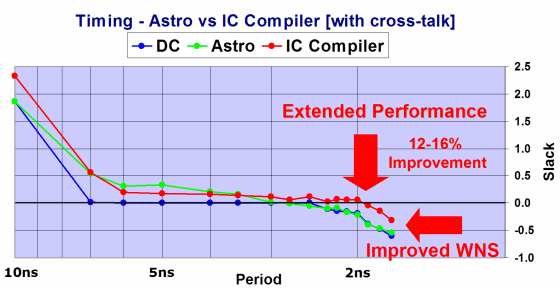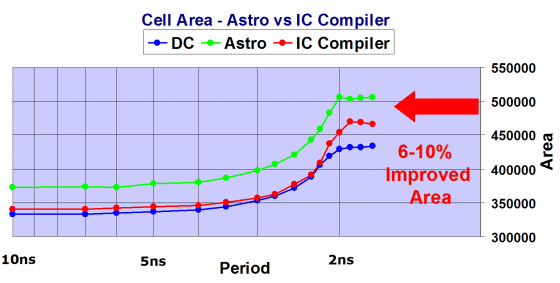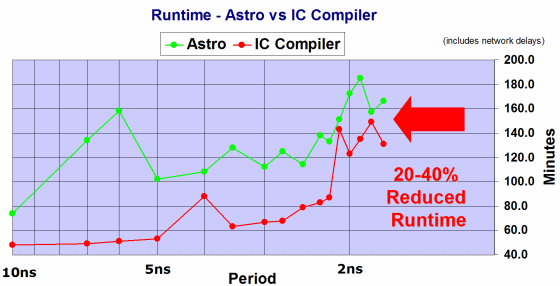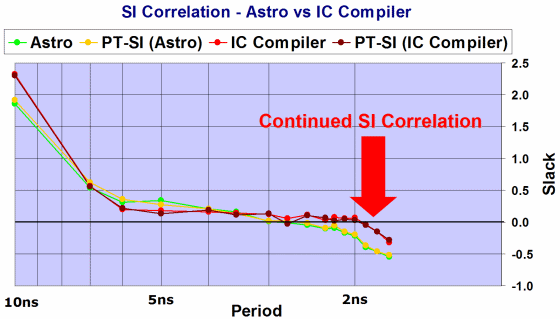( ESNUG 442 Item 2 ) -------------------------------------------- [03/24/05]
Subject: ( SNUG 04 #11 ) User Benchmark of Astro vs. IC Compiler (Galileo)
> WHAT IS GALILEO? There I am, putting together this trip report, pawing
> over the PhysOpt user responses to the survey and out pops:
>
> "We do not use PhysOpt, but are looking forward to Galileo."
>
> - [ An Anon Engineer ]
>
> Hmmmm... What is "Galileo" ? I called up one of the marketing hacks at
> Synopsys and left a voicemail. I went back to work on the report. A day
> later, the hack calls back. "Galileo was a 16th century astronomer first
> to use a telescope to make major astronomical discoveries." -- what the!?
> I balk loudly over the phone. "OK. I can also tell you that Galileo was
> a NASA spacecraft that probed the atmosphere of Jupiter in 1995. That is
> all I am authorized to say on this question." WHAT?! Huh? What the %#@*
> is bloody "Galileo" !!??
>
> - from http://www.deepchip.com/items/snug04-11.html
From: Clay Schneider <clayschneider=user domain=agere spot calm>
Hi, John,
Here's our benchmark of Astro 2004.06.sp1_3 vs. the Galileo Feb05 release
(which Synopsys Marketing is now calling "IC Compiler".) In a 110 K gate,
90 nm test design, we frequency stepped from 100 Mhz to 550 MHz in 15
intervals. We synthesized using DC at each frequency. We ran the
experiment starting with identical utilizations and pin locations. Metrics
measured for each frequency step:
- WNS
- Area
- Runtime
- Correlation to PrimeTime-SI
Here are the graphs of the data we found for WNS:
 We were pleased to see IC Compiler extended WNS performance by roughly 12%
to 16% over Astro as the frequency went up.
For our overall design area:
We were pleased to see IC Compiler extended WNS performance by roughly 12%
to 16% over Astro as the frequency went up.
For our overall design area:
 It kind of surprized us that IC Compiler maintained a consistantly 10%
smaller area across all frequencies.
For our runtime of Astro 2004.06.sp1_3 vs. Galileo Feb05:
It kind of surprized us that IC Compiler maintained a consistantly 10%
smaller area across all frequencies.
For our runtime of Astro 2004.06.sp1_3 vs. Galileo Feb05:
 Because we ran our test across a network working on real designs, it's
important to note that the absolute runtime minutes are skewed because of
network delays. What's more important here is that the green line (for
IC Compiler) stays 20% to 40% relatively below the red line (for Astro.)
For correlation vs. PrimeTime-SI:
Because we ran our test across a network working on real designs, it's
important to note that the absolute runtime minutes are skewed because of
network delays. What's more important here is that the green line (for
IC Compiler) stays 20% to 40% relatively below the red line (for Astro.)
For correlation vs. PrimeTime-SI:
 It took us months to get that correlation between PrimeTime-SI and Astro;
while IC Compiler had this correlation out of the box. We were impressed.
Overall, IC Compiler benchmarked well:
- Improved WNS by 12-16%
- 6% to 10% smaller area
- 20% to 40% faster runtimes
Our next steps testing IC Compiler are to add power optimization to the
sweep analysis and to validate IC Compiler's promised functionality of:
- Concurrent multi-mode timing
- Multi-voltage support
- Multi-corner analysis
- Advanced CTS, floorplanning, chip finishing capabilities
It's our plan to deploy IC Compiler in production targeting 90 nm designs
starting in the 2nd half of the 2005 Calendar Year.
- Clay Schneider
Agere Systems Allentown, PA
It took us months to get that correlation between PrimeTime-SI and Astro;
while IC Compiler had this correlation out of the box. We were impressed.
Overall, IC Compiler benchmarked well:
- Improved WNS by 12-16%
- 6% to 10% smaller area
- 20% to 40% faster runtimes
Our next steps testing IC Compiler are to add power optimization to the
sweep analysis and to validate IC Compiler's promised functionality of:
- Concurrent multi-mode timing
- Multi-voltage support
- Multi-corner analysis
- Advanced CTS, floorplanning, chip finishing capabilities
It's our plan to deploy IC Compiler in production targeting 90 nm designs
starting in the 2nd half of the 2005 Calendar Year.
- Clay Schneider
Agere Systems Allentown, PA
Index
Next->Item
|
|



